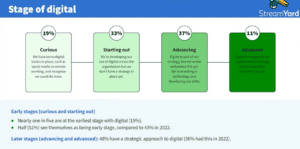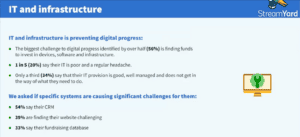The Charity Digital Skills report, now in its sixth year, is widely regarded as an annual barometer on digital maturity, skills and priorities across the nonprofit sector. It’s the digital sister of our own annual Charity Tech Leaders Report which focuses on IT infrastructure, M365 & cloud, outsourcing and cyber security.
In this blog, we summarise some of the key takeaways from the 2023 Charity Digital Skills report, with our thoughts and advice on what it means for charities from where we sit as modern workplace specialists.
Cost of Living Crisis
The report quoted that ‘the cost of living crisis has become a significant issue for the digital progress of some charities, meaning that there is less to spend on tools and upskilling.’
Budgets are indeed being squeezed. Our own research found that IT teams are focusing on optimising what they have, rather than buying new. Getting the foundations right is also still something a lot of charities are trying to solve, as the report quotes that ‘spending less time on administrative tasks is a growing need for charities, at 37% compared to 31% last year.’
In terms of digital maturity, 50% of respondents reported they were at an early stage in their digital journeys. The cost-of-living crisis is affecting these charities, and marginalised groups, the most. The biggest challenge to digital progress is finding funds to invest in devices, software and infrastructure.

There is always room to optimise and make better use of the tools you have already. We still find many charities’ core IT systems lack integration or Single Sign On, and even simply centralising procurement and auditing what you have can be valuable (it’s not unheard of for different teams to be using the same tool, on separate subscriptions, without even knowing it).
Optimising what you already have presents significant opportunities to vastly improve the status quo for relatively little cost. One of our most popular projects over the last 3 years has been helping make full use of M365 and Azure. This means more than “email, Teams and SharePoint”. Many charities miss out on core features included in M365 that, once embedded, means their whole IT estate can be deployed, secured, managed and maintained in one place. Technologies like Microsoft Intune solve the headache of juggling corporate and personal phones and devices. Microsoft Autopilot solves the time-consuming task of rolling out laptops to new starters, fully automating the setup to your organisation’s specification and settings. Both these tools are free and included in most Microsoft charity subscriptions like Business Premium and E3. We set out this model in what we call the Non-Profit Modern Workplace.
So, to coin a phrase from Microsoft’s CEO recently, it is very possible to “do more with less” if we all focus on making the most of what existing tools and systems can do.
IT Support
We were disheartened to see only 34% said their IT provision is ‘good, well-managed and does not get in the way of what they need to do.’ This is a very low statistic which speaks for the state of the market in general, with hugely varying cost and quality of service in charity IT.

A big factor here is that many struggle to attract and retain IT talent as wages and cost of living inflate dramatically. Corporate salaries become impossible to ignore for IT staff who, up until now, have accepted lower pay in order to work for a cause they love.
A growing trend we are seeing is “co-managed” IT: hybrid IT teams that blend in-house with outsourced experts into one team. This combines the benefits of in-house staff who know the charity inside out, with IT partners who have a charity sector focus providing specialist skills like cyber, and everyday management and infrastructure maintenance. By leaning on outsourcers to do the tasks they are best at, it also frees up your IT team to work on more valuable engagement with staff, which in turn feeds job satisfaction and retention. We’ve run a couple of very popular webinars on successful IT outsourcing, and a paper summarising the key recommendations is here.
AI
According to the report, 78% agree that AI is relevant to their charity and could transform it, yet 73% say they don’t feel prepared to respond to the opportunities and challenges it brings.
Charities are not alone in this mindset; one large tech company we know have completely banned ChatGPT. In our own report on the state of charity IT in early 2023, 73% of respondents did not see AI as a priority. There’s no doubt that AI is the future, but there are challenges that need to be worked through first as we prepare to embed these tools further within our organisations:
- Governance – including AI policy, data security & permissions, GDPR factors and data protection. Have you issued any guidance or advice to your staff on use of ChatGPT yet?
- Data – the Large Learning Models (LLMs) need big data sets to be fed into them if AI is to be of any value. Most charities will need external expertise and guidance to connect their existing data siloes, and restructure data.
- Use Cases – many people are wondering how their organisation can properly leverage AI and Chat to improve what they do. This requires creative thinking coupled with basic understanding of the building blocks of AI and LLMs to come up with potential use cases.
Whilst these are all big issues that need planning and thought, one AI service we could very quickly get used to is Microsoft Copilot – expected to launch later this year as an AI virtual assistant built into Microsoft 365. It’s something we think will make a big difference in cutting down manual work. You can read more about Copilot and its capabilities in our recent blog.
Cyber Security
Cyber security remains a key focus area for charities. The report states that ‘improving data security, privacy and GDPR compliance has become more of a priority since 2022. 46% of charities now see this as a priority compared to 35% last year.’
However, it also quoted that ‘71% of organisations are either poor or fair at cyber security.’ We find the same message coming from the charities we look after, with an increasing talent shortage for these specialist roles making recruiting them internally very difficult or expensive.
Equally, the Data Protection Officer role has long been seen as a crown of thorns, worn by a nominated person who also has a regular day job. There’s a growing trend for using specialists in this area either ad-hoc, or by introducing an ongoing Helpdesk style service like we do at Smartdesc.
On the cyber front, it’s alarming to see so many charities have such low confidence in their cyber security (although maybe no surprise given constant media coverage of attacks). A good cyber strategy needn’t be overly complex; proactive controls like awareness training for all staff, testing staff knowledge through simulations, accreditations like Cyber Essentials Plus and centralised control and updates of devices to keep them secure through tools like Intune are fairly low cost nowadays.
These measures can be blended with reactive controls like Defender for 365, SASE tools that allow devices to connect to any internet connection safely, and obvious things like Two Factor Authentication, go a long way to make your organisation less appealing than the next – which is the essence of “good” cyber security. To reach this state without having to hire an incredibly expensive Cyber Security lead, many charities are using services like vCSO, who provide part time cyber strategy leadership and oversight, as an ongoing service for a fraction of the cost. The National Cyber Security Centre (NCSC)’s “10 Steps to Cyber Security” is also being widely adopted in the sector and is a great framework to align best practice to.
Conclusion
This year’s report is another great pulse check of the state of IT and Digital in the sector. It highlights the impact of the ongoing cost of living crisis on IT provision and digital journeys, particularly for smaller charities, and how it’s more important than ever that charities optimise their IT to do more with less. The emergence of AI also presents opportunities in this area to improve efficiencies but needs to be approached with caution.
It’s very difficult to move a digital strategy forward and think about things like CRM and ERP without the foundations of good IT infrastructure, modern workplace tools that make managing the state easier, digitally confident staff and volunteers trained on the basics, and an IT Partner by your side. These challenges may seem daunting, but they are absolutely possible to overcome. The “drag on productivity” and documenting this by mapping “as-is” processes and aspirations to show the potential ROI from investment for your board, is an excellent takeaway.
If you’d like help making your business case for sorting out your IT foundations, optimising systems like 365, training your staff on the basics and getting to a solid cyber security baseline, get in touch.
Read the full Charity Digital Skills Report 2023 here.
